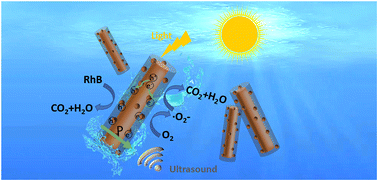Metal–organic framework-derived porous carbon-mediated ZnO–nano-ZnO core–shell structure with excellent photocatalytic activity†
Abstract
Considering the large specific surface area, abundant active sites, and good electrical conductivity of metal–organic framework (MOF)-derived porous carbon materials, the rational design and fabrication of high-performance composite photocatalysts with tunable morphology and configuration are an extremely important and challenging topic to remove organic dyes from wastewater through the photocatalytic reaction. In this work, the ZnO–nano ZnO@porous carbon (ZnO–nZnO@PC) was in situ fabricated through the Ostwald ripening mechanism and facile pyrolysis process. The ZnO nanorods acted as a self-sacrificing template for achieving the tight binding of the ZnO–ZIF-8 core–shell structure with the thickness of the carbon layer regulated by controlling the amount of ligand, which was directly converted into nano-ZnO encapsulated with porous carbon materials through post-annealing process, improving the specific surface area, adsorption capacity of dye molecule, and transportation of charge carriers. Moreover, nano-ZnO in porous carbon shell further improves the photocatalytic activity. In addition, the piezoelectric effect produced by the internal polarized electric field of ZnO under the influence of ultrasonic energy provided by ultrasonic waves acts as a powerful driving force for the separation of photogenerated carriers, further enhancing the activity of photocatalytic degradation.



 Please wait while we load your content...
Please wait while we load your content...